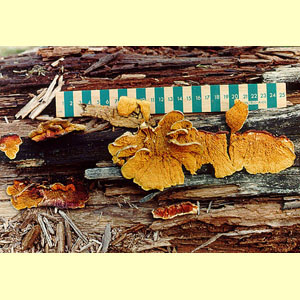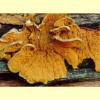
images/Meiorganum_olivaceoflavidum_group/Meiorganum_olivaceoflavidus_NHS2619.jpg
Medium to very large agaric, growing on wood, with a yellowish or yellowish brown spore print with distinct olive tint when fresh. Pileus yellow, brown or green, not viscid. Stipe absent or dorsally attached. Lamellae quite wavy or corrugated when viewed end-on, with many forks and interconnections shallower than the depth of the main lamellae, yellow to brown, drying dark brown. Odour strong and unpleasant in dried material. Partial veil remnants absent. Spores cylindrical, hyaline or pale, non-amyloid, smooth; germ pore absent. Cheilocystidia absent. Lamellar trama interwoven or bilateral. Pileipellis a trichoderm. Clamp connections present.
Compare carefully with the
Tapinella panuoides group, which differs in the broader spores (more than 2.5 μm wide) which dextrinoid and not cylindrical.
Tapinella panuoides can also have purple tints to the pileus.
The only other fleshy, stipe-less pale to dark brown-spored agarics are Melanotus and Crepidotus, which both have normal lamellae without interconnections. In addition, the spores of the former have a germ pore and those of the latter are often warty.
Meiorganum R.Heim, Rev. Mycol. (Paris) 31: 157 (1966).
One or two species:
Meiorganum olivaceoflavidum (=
Paxillus) which is very similar to, and possibly conspecific with,
M. curtisii. The separation of these species and their relationship to
Tapinella panuoides and its allies needs further work.
Some material originally lodged in MEL as M. curtisii is better identified as Tapinella aff. panuoides because of the shortly ellipsoid dextrinoid spores. The illustration of Tapinella curtisii in Fuhrer (2005) may also be of Tapinella aff. panuoides.
The type species of Meiorganum (M. neoclaedonicum, from New Caledonia, Singapore, Sumatra and Borneo) is truly poroid.
Meiorganum olivaceoflavidum (Cooke & Massee) T.H.Li & Watling, Edinburgh J. Bot. 56: 147 (1999).
W.A., Vic. and Tas. (possibly also Qld and N.S.W.).
In native forests, and in pine plantations.
On wood.
Saprotrophic.
Baldoni, D.B., Coelho, G., Jacques, R.J.S., Silveira, R.M.B., Grebenc, T. & Antoniolli, Z.I. (2012), Brown rotting fungus closely related to
Pseudomerulius curtisii (Boletales) recorded for the first time in South America,
Mycosphere 3: 533–541. [
Description,
Microcharacters and
Illustration of
M. curtisii (as
Pseudomerulius), from South America]
Fuhrer, B. (2005), A Field Guide to Australian Fungi. Bloomings Books, Hawthorn. [Description and Illustration of M. curtisii (as Tapinella), although the illustration could be of Tapinella aff. panuoides]
Reid, D.A. (1956), New or interesting records of Australasian Basidiomycetes, Kew Bull. 1955: 631–648.[Description and Microcharacters of M. olivaceoflavidum (as Paxillus)]
Singer, R., Garcia, J. & Gomez, L.D. (1990), The Boletineae of Mexico and Central America I & II, Beih. Nova Hedwigia 98: 1–70. [Description, Illustration and Microcharacters of M. curtisii from Mexico]
Watling, R. & Gregory, N.M. (1991), Observations on the boletes of the Cooloola sandmass, Queensland and notes on their distribution in Australia. - Part 3: lamellate taxa, Edinburgh J. Bot. 48: 353–391. [Discussion on M. olivaceoflavidum (as Paxillus)]
Watling, R. & Li, T.-H. (1999), Further observations on the boletes of the Cooloola Sandmass, Queensland and extralimital area, in R.Watling & T.H.Li, Australian Boletes: a Preliminary Survey, 27–71. Royal Botanic Garden, Edinburgh. [Description and Microcharacters of M. olivaceoflavidum]



